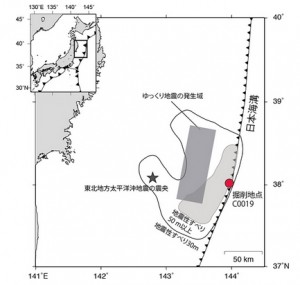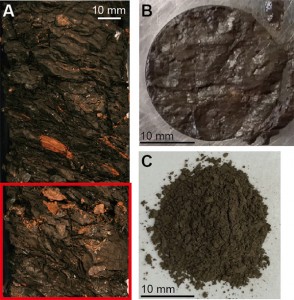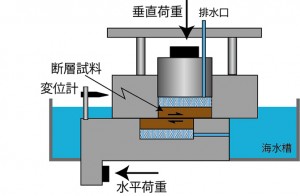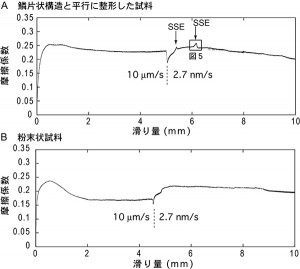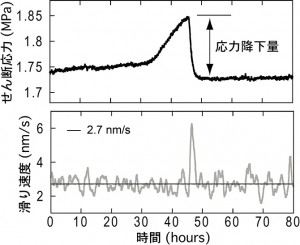Press Release – Slow Slip Area May Also Rupture During Megathrust Earthquakes
- Media Coverage
A research team led by Dr. Yoshihiro Ito and Dr. Kohtaro Ujiie, Visiting Senior Scientists from Plate Boundary Drilling Research Group of Research and Development (R & D) Center for Ocean Drilling Science at the Japan Agency for Marine-Earth Science and Technology (JAMSTEC: Asahiko Taira, President) with University of Bremen, Disaster Prevention Research Institute at Kyoto University, and University of Tsukuba, successfully reproduced slow earthquakes*1 detected before the 2011 Tohoku-Oki earthquake in laboratory friction experiments. Unlike regular earthquakes when rocks on faults slip suddenly in several seconds to several tens of seconds, slow earthquakes are characterized by very slow slip movements of faults, lasting several days to more than a year. Recently, slow earthquakes have come to draw particular attention as they may be related to megathrust earthquakes.
The samples used for the laboratory experiments were collected from the 2011 Tohoku-Oki earthquake fault zone recovered during the IODP*2Expedition 343, “Japan Trench Fast Drilling Project (JFAST)” carried out byChikyu from April 1st to May 24th in 2012 (reported by press releases issued onMarch 9th and May 25th in 2012). Previous laboratory experiments using the same samples had reproduced a large coseismic slip of the 2011 Tohoku-Oki earthquake and revealed the fault slip mechanism during the earthquake (reported by press release issued on December 6th, 2013). The team’s new study found that, not only high-velocity slip but also slow slip events could occur on shallow portions of plate boundary faults. It urges scientists to review conventional models suggesting that megathrust earthquakes occur in locked zones.
These study results were posted on a British scientific journal, Nature Geoscience on October 16th, 2015 (JST).
Illustrations by Nariyuki Yoshiwara
Figure 1: Drilling site (C0019), the epicenter (star) and the rupture area of the 2011 Tohoku-Oki earthquake. The light gray area is the huge coseismic slip of >50 m. Slow slip area is shown by dark gray. The samples for laboratory experiments were collected from the plate boundary fault at 820 meters below seafloor at site C0019.
Figure 2: (A) Occurrence of the plate boundary fault, showing scaly fabric. Red rectangular indicates the interval used for the laboratory experiments. Two types of samples: (B) intact samples formed parallel to scaly fabric; (C) powered samples.
Figure 3: Schematic diagram of the single-direct shear apparatus. Not to scale.
Figure 4: Experimental results using two types of samples from the plate boundary fault.
A) intact samples formed parallel to scaly fabric and B) powered samples. SSE denotes slow slip events. Box indicates the close-up view shown in Fig. 5.
Figure 5: Close-up view of experimental data showing slow slip events observed in the experiemnts using intact samples. The stress drop of ~120 kPa (equivalent to 0.12 MPa) occurred over a few hours, during which slip velocity increased from 2.7 nm/s to 6.3nm/s.
For further information, please refer to the Press Release by Japan Agency for Marine-Earth Science and Technology (JAMSTEC).






